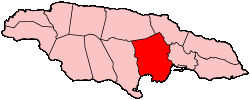
Population: 411,600 (1999)
Capital: Spanish Town
Major Towns: Old Harbour, Bog Walk, Linstead, Ewarton, Portmore

St. Catherine is the third largest parish in Jamaica, covering approximately 1,192.4 square kilometers (460.4 square miles) in the southern region of the island. Known for its expansive flat plains and the scenic Hellshire Hills, the parish seamlessly blends natural beauty with a deep-rooted historical legacy.
The fertile plains of the Rio Cobre basin, spanning nearly 57,000 acres, are nourished by the vital Rio Cobre River – a key water source for irrigation and hydroelectric power. Additionally, the region boasts significant wetlands, including the Hellshire/Cabaritta swamp, the Great Salt Pond, and Hunts Bay Dawkins Pond.
Rich in mineral resources, St. Catherine is home to deposits of bauxite, copper, limestone, commercial marble, clay, sand, and gravel. Its underground world is equally remarkable, with 44 caves—St. Clair Cave near Polly Ground stands as one of the longest penetrable caves in Jamaica.
Established in 1534 and named after Queen Katherine of Portugal, St. Catherine was the site of Jamaica’s first Spanish settlement, originally located at Seville and later relocated to Santiago de la Vega (modern-day Spanish Town). The area flourished under early sugar cultivation during both Spanish and English rule, with Spanish Town serving as the administrative capital until 1872.
Spanish Town’s Georgian Square, adorned with the Rodney Memorial and the former House of Assembly, remains a testament to the parish’s rich colonial heritage and vibrant cultural history.
Agriculture: Small-scale mixed farming thrives here with crops such as bananas, coconuts, pineapples, citrus, pumpkins, peppers, coffee, and callaloo, while larger estates focus on sugar cane, bananas, and citrus.
Dairy and Fish Farms: St. Catherine is home to numerous dairy farms—including a thousand-acre model farm in Old Harbour—and is renowned for its high-quality fish from Hanson and Dawkins Salt Ponds.
Industries: As a major industrial hub, St. Catherine boasts key facilities such as Alcan’s salt plant in Ewarton and is one of the leading industrial centers outside Kingston and St. Andrew. It also hosts two of the remaining sugar factories in Jamaica, at Bernard Lodge and Worthy Park.
Colbeck Castle: This historic ruin, located 2.4 km northwest of Old Harbour, is believed to have been built by John Colbeck of the Penn and Venables army in 1655.
Old Iron Bridge: Dating back to 1801 and built on a foundation from 1675, this is one of the oldest surviving iron bridges in the Western Hemisphere.
Mountain River Cave: Near Guanaboa Vale, this cave features approximately 200 Arawak petroglyphs that date back 1,300 years.
Rio Cobre River and Gorge: One of Jamaica’s largest rivers, the Rio Cobre irrigates 18,000 acres and carves a dramatic gorge with walls reaching up to 700 feet.
Emancipation Square: Formerly Spanish Town Square, this historic plaza features stunning Georgian architecture, including Kings House, the House of Assembly, and the Rodney Memorial.
St. James Cathedral: Also known as the Parish Church for St. Catherine, this Anglican Cathedral is built on the site of one of the earliest Spanish churches in the Americas.
White Marl Arawak Museum: Designed like an Arawak hut and located on the site of an ancient Arawak village, this museum displays artifacts that celebrate the indigenous contributions to Jamaican culture.